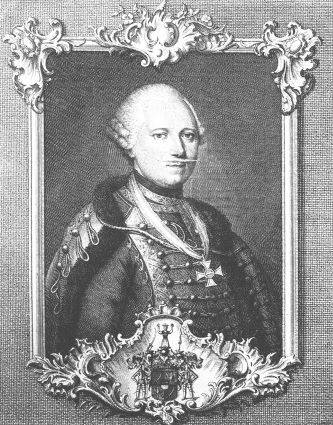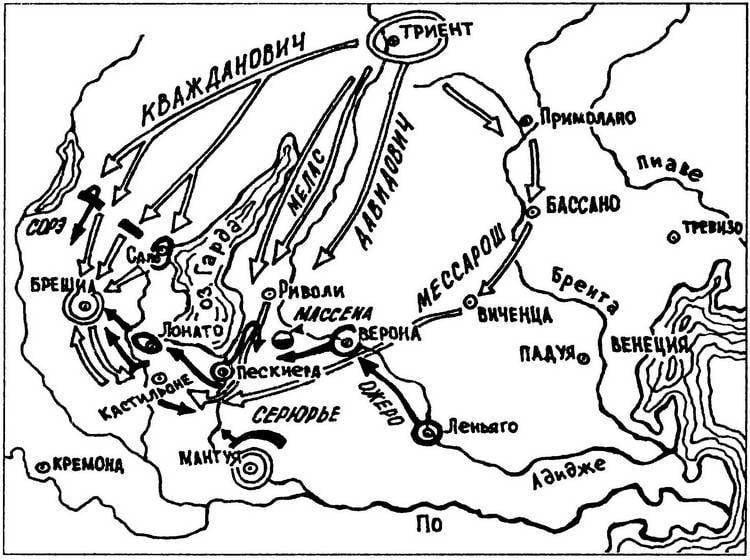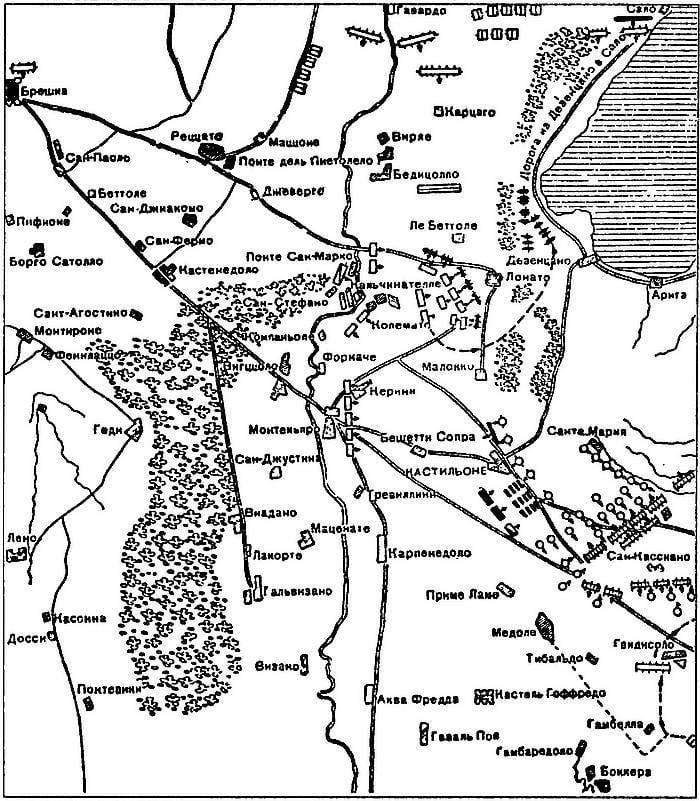Battle of Lonato and Castiglione
Napoleon Bonaparte
220 years ago, 3-5 August, French troops under the command of Napoleon defeated Austrian troops under the command of Field Marshal von Wurmzer in the battles of Lonato and Castiglione. The Austrian high command sent additional troops to the Italian front and tried to stop Napoleon’s attack and unlock Mantua, but the Austrians ’first attack to free Mantua failed. 5 August 1796 of the year in the general battle of Castiglione Wurmzer was defeated by Napoleon’s army.
The situation on the Italian front
The victory at Lodi allowed the French army under the command of Napoleon to occupy the whole of Lombardy along the Adda River. A part of the French troops under the command of Murat on June 29, 1796 occupied Livorno, having liquidated the English base there. fleet. General Augereau occupied Bologna. Bonaparte in mid-June personally occupied Modena, then it was Tuscany's turn, although the Duke of Tuscany was neutral in this war. Having secured its rear with the arrangement of shops along the left bank of the Po River, the French commander crossed May 30 through Mincio, drove back the troops of the Austrian general Beaulieu and after a series of brilliant maneuvers forced him to retreat to Tyrol. On June 4, the French army besieged Mantua. Now all of Northern Italy was in the hands of Napoleon.
Mantua was considered the key to Italy. Its garrison was 13 thousand people and had food reserves on the 2,5 month. The fortress, which was considered impregnable, was covered from the north and east by lakes, and from south to west - by marshes overgrown with reeds, passing only along the five existing dams. It was difficult to take it, however, it was possible to block with small forces. Having advanced Massena's division with a barrier against the forces of Beaulieu, retreating to the north, Napoleon blocked Mantua and, receiving siege weapons from Milan and Ferrara, began a gradual siege of the fortress. Most of the French troops are located along the Adige River, thereby carrying out the cover of the siege of the fortress. Further fighting of the Austrians and the French for eight months proceeded in the struggle for Mantua, which the Austrians tried to unlock.
Meanwhile, Napoleon came into conflict with the supreme leadership. Capturing and imposing indemnity on the richest areas of Northern Italy, Napoleon was able to afford wide gestures. 20 May 1796, the commander-in-chief of the Italian army, announced to soldiers that they would receive half their salary in a specie. None of the armies of the Republic did not pay. He decided it alone, without asking anyone for permission. In Paris, this excessive autonomy caused irritation, but in the Italian Army, of course, Napoleon’s decision was greeted with a bang.
Earlier, on May 13, Napoleon received an order from the Directory that the army operating in Italy would be divided into two independent armies. One, operating in the north, will be led by General Kellerman, the second, under the command of General Napoleon, numbering thousands of soldiers in 25, must go to Rome and Naples. This order came after the victory at Lodi (May 10) and completely contradicted Napoleon’s plans and the overall military-strategic situation. Napoleon reported to Paris that it was against the interests of the Republic to divide the Italian army. He stated briefly and clearly: "One bad general is better than two good ones." And in his inherent style, he aggravated the situation: “The position of the army of the Republic in Italy is such that you need to have a commander who enjoys your complete confidence; if it is not me, you will not hear complaints from me ... Everyone wages war as best he can. General Kellerman is more experienced than me: he will lead her better; together we will lead her badly. " Napoleon threatened resignation.
The directory could not accept the resignation of a brilliant general who brought France an unexpected victory in Italy. Moreover, the army of Jourdan and Moreau, on which the French government made a major stake in the war of Austria, failed. The only army that shunned the attention of all of Europe was the only wretched Italian army that was the only army that quickly advanced and regularly reported on loud victories. Napoleon's victories strengthened the position and prestige of the Directory. In addition, the Directory represented a large, mostly new, speculative, parasitic bourgeoisie, and in foreign policy, it wanted the same as inside the country: enrichment in the form of territorial seizures, looting areas and indemnities. And the Italian army only sent not only news of victories and enemy banners, but also gold. For example, the army of Jourdan and Moreau not only did not send gold, moreover, their armies demanded large expenses. During the financial crisis, the corruption that afflicted all of France, the greed of the members of the government and the entire administrative apparatus, this circumstance was of paramount importance. For gold, Napoleon could be forgiven for very much. So, a few days after joining Milan, Commissioner Salichetti informed the Directory that the conquered areas, not counting Modena and Parma, had already paid 35,5 millions. Therefore, the Directory Government could not accept the resignation of such a successful general. With another commander, the flow of gold could have stopped.
Thus, Napoleon correctly calculated everything and remained the commander of the unified Italian army. The order for the division of the army in Italy was forgotten.
Forces and plans of the parties
Napoleon at that time had about 56 thousand people, of whom 10 thousand were located in the rear, guarding fortresses and communications and 11 thousand under Mantua. French troops were deployed on a wide front in 120 km. Communication with Milan was provided by the newly formed division of Sora, who watched the mountain passes from Salo and beyond. The blockade of Mantua was assigned to the Serurerie division. Massena’s division occupied Verona and Peschiera and observed the space from Lake Garda to the Adiza River; Augereau was on the Adige River, between Verona and Legnago; Despinois's division and cavalry stood at Roverbella, making up a reserve. The division of Lagarpa who was killed in battle was disbanded, and its personnel were distributed among other divisions. Thus, for actions in the field, Napoleon had about 35 thousand people left.
Given the succession of defeats of the Austrian army in Italy, the gofkrygsrat (court military council) decided to strengthen the Italian army. Troops removed from the Rhine Front. The passivity of Jourdan in the German sector allowed the Austrian high command to strengthen its forces in the Italian theater of operations, transferring General Wurmzer’s army here. The 20 battalions and 16 squadrons approached the Italian front in May on the 8, then the talented commander Dagobert von Wurmzer with the 19 battalions and 18 squadrons arrived from the Army of the Rhine. He took command of the army at the end of May from Beaulieu. By July 20, Wurmzer had a 50-thousand. army, not counting the garrison of Mantua (13 thousands of people). Wurmzer, at the direction of the Gofkrygsrat, was to undertake an offensive operation to unleash the Mantua and oust the French from Lombardy.

Austrian Army Commander Dagobert Sigismund von Wurmzer
Wurmzer was planning an offensive in four columns on a broad front, intending to later combine them for action near Mantua. The column of General Kvázhdanovich (17 thousand soldiers and 52 guns) was to attack west of Lake Garda in order to cut the message of the French troops with Milan. The column of Melas (15 thousand people and 52 guns) was ordered to move east of the lake in the direction of Rivoli. Davidov's column (10 thousand soldiers with 60 guns) was sent along the left bank of the Adige River, and the column Messarosh (5 thousand men and 18 guns) was launched at Bassano and Vicenza for demonstrative purposes. Wurmzer himself moved with a column of Melas. Thus, Wurmzer crushed his army, his troops were to unite only when they met with the main forces of the enemy. Napoleon had the opportunity to act along internal operational lines and to concentrate superior forces in comparison with each of the individual enemy columns. The French commander, acting quickly and decisively, could smash the enemy in parts.

The first offensive Wurmzer. 1796 year. Source: V.V. Beshanov. Sixty Napoleon Battles
The first Austrian attack on Mantua. Battles of Lonato and Castiglione
The preparation of the Austrian army for the offensive did not remain a secret for the French, but their intentions were not yet clear. July 28 Austrian columns began an offensive march. The initial actions of Kvázhdanovich were successful. Under the onslaught of the enemy, the French cleared Salo and mountain passes leading to the valley of the river Po. On July 30, Kvázhdanovich’s troops had already occupied Brescia. They intercepted the road Milan-Mantua and advanced units advanced to Montepiaro. Thus, Kvazhdanovich was on the posts of the French army. In the future, Kvazhanovich, advancing to the southeast, was going to join up with Wurmzer and surround the French army.
In order to delay the movement of Wurmzer’s column on the main line, Napoleon dispatched Massena’s division. But Wurmzer’s troops dropped her. Massein was brought to the aid of Augereau’s division, but the Austrians also rejected her. July 29 Column of Melas-Wurmzer with the battle occupied the Rivoli plateau. The situation became extremely dangerous for the French army, and here Napoleon made his own maneuver, which, according to military researchers, could by itself provide him with immortal fame, even if he were killed then.
Having received reports of the failures of the French troops at Salo and Rivoli, a military council was assembled, in which the majority spoke in favor of retreating across the Olio River, but Augereau advised to go on the offensive. Napoleon decided to attack the enemy. Napoleon planned on the night of 30 on 31 in July to lift the siege of Mantua, to abandon the siege artillery park and to gather as much force as possible to strike at Quvdanovic’s corps, putting barriers against Melas’s column. The French commander-in-chief began concentrating his forces at Lonato and Montekiaro. Moreover, the units brought by Augereau and Kilmen, moving forward, drove the Austrians out of Brescia, and Soret reoccupied Salo, providing the French with Milan.
In the meantime, Wurmzer celebrated his victory. He quietly entered Mantua, removing from her, thus, a siege. There, the Austrian commander learned that Napoleon had gone east with all his might. After some hesitation, Wurmzer left the fortress, throwing back the barrier of the French under the command of Valletta. He then ferried across the Mincio column of Melas and Messarosh to the rear of the French army. As a result, Napoleon’s troops appeared between the troops of Wurmzer and Kvázhdanovich. Having recognized his position as a very risky one, Napoleon even thought about a retreat, but after the meeting with the generals, he retained the old plan: first to strike at Kvadzhanovich. The divisions of Augereau and Kilmen were abandoned against Wurmzer at Montekiaro.
On August 3, Napoleon threw his remaining troops against Kvadzhanovich to the north of Lonato and defeated the enemy. One of the columns surrendered, the rest moved to the north. Then Napoleon turned his army against Wurmzer. The Austrian commander, having learned about the failure of Kvazhdanovich, nevertheless decided to attack the enemy and deployed his troops into battle formation at Castiglione.
The battle of Castiglione began on 5 on August 1796, around 6 in the morning. Napoleon bound the main forces of the Austrians in the center and on the right flank, and delivered the main blow to their left wing of the enemy. By the 9 clock, General Verdier’s division, operating on the main line, captured Medolet’s dominant height and, setting up artillery on it, opened flanking fire on the main forces of the Austrian army. The Austrians stubbornly fought back, but the exit to them on the flank and rear of the advanced units of General Seryurye’s division, which had come from Mantua, and the simultaneous strike from the front of the entire French army, decided the outcome of the battle. The Austrians retreated.

Battle of Castiglione
Results
The defeated Austrian army of Wurmzer retreated to the north, losing 3 thousand people and 20 guns. Thus, the more advanced tactics of the French - the columns in combination with the loose system - showed their superiority over the outdated linear tactics of the Austrians. While Wurmzer distributed his troops evenly along the whole line, without allocating even a reserve, Napoleon produced a concentration of forces and assets in the main line. A strong frontal strike combined with a maneuver in the flank and rear of the enemy ensured his victory.
The Austrian command sprayed its forces, acted slowly, hesitantly, which led to the defeat of the entire offensive operation. Napoleon, on the contrary, acted decisively and quickly. He set the goals correctly: he decided to lift the siege of Mantua and abandon his siege park, which would crush the advancing enemy troops in pieces. Having concentrated forces in one direction, he broke and threw back the army of the enemy. Then the French troops again besieged Mantua.
After the siege was lifted from Mantua, an Austrian detachment was sent out of the fortress to pursue Serouye's troops. However, due to the failure of the army of Wurmzer, the detachment went to Mantua. The remnants of the army Wurmzer left in Tyrol. The total loss of the Austrians in the first attempt to unlock Mantua was 13 thousand people and 71 gun. The French lost 4 thousand people, as well as 187 siege guns, abandoned under Mantua - this was the most severe and irreparable loss. However, besides reflecting the offensive of the enemy, this victory gave enormous moral advantages.
Napoleon always took this into account: “The Austrian army after its defeat still consisted of 40 000 people, but from now on, one battalion of the Italian army put four enemy forces to flight, and everywhere the French seized guns, prisoners and military equipment. Wurmzer, however, supplied with supplies the garrison of Mantua. He brought out the brigades of Rokkovin and Vukasovich from there, which he replaced with fresh troops, but he took only half of his beautiful army with him, and nothing could compare with the demoralization of this army and the loss of its fighting efficiency after the failures suffered. ”
As historian A.Z. Manfred noted: “In the 1796-1797 campaign, Bonaparte proved himself to be a brilliant master of maneuver warfare. In principle, he continued only the new that was created before him by the armies of revolutionary France. It was a new tactic of columns, combined with a loose system and the ability to provide an unusual speed of movement in a limited area of quantitative superiority over the enemy, the ability to concentrate forces in the shock fist, breaking through the resistance of the enemy in his weak spot. This new tactic has already been applied by Jourdan, Gosh, Marceau; it was already analyzed and synthesized by the synthetic mind of Lazar Carnot, but Bonaparte managed to breathe new force into it, to reveal the possibilities hidden in it. ”
Information